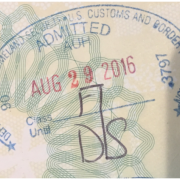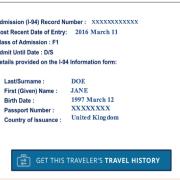Important Terms You Should Know
Below you will find some common immigration-related terms and acronyms used on our website and elsewhere.
We strongly recommend that you familiarize yourself with these terms and their definitions. And when in doubt, always feel free to email us.
- CBP
- DHS
- DS-2019
- EAD Card
- Entry Stamp
- Grace Period
- I-20
- I-515A
- I-901 Fee (SEVIS Fee)
- I-94
- ICE
- Passport Bio Page
- POE
- SEVIS
- SEVP
- Unlawful Presence
- USCIS
- Visa
CBP
Customs and Border Protection (CBP): The CBP is the US government law enforcement agency responsible for the oversight of national border security. When you travel to the US and request entry at an airport or another border crossing, a CBP officer will examine your documents for entry.
DHS
Department of Homeland Security (DHS): The DHS is the US government agency responsible for the oversight of national security. The DHS oversees several other government offices including Customs and Border Protection (CBP) and the US Citizenship and Immigration Services (USCIS).
DS-2019
Form DS-2019: The DS-2019, also called the "Certificate of Eligibility for Exchange Visitor (J-1) Status," is the primary document needed for exchange visitors to apply for a J-1 visa and to provide proof of their J-1 status. The form is issued by your host institution. It will outline important personal details, program information, and relevant immigration regulations.
A sample DS-2019 form can be found on Study in the States, a helpful international student resource site maintained by the Department of Homeland Security (DHS).
EAD Card
Employment Authorization Document (EAD or EAD Card): An EAD is a card that provides evidence of authorization for employment. You would receive an EAD card if, for example, you are an F-1 student who applied for and was granted Optional Practical Training (OPT) for off-campus employment.
A sample EAD card can be found on the US Citizenship and Immigration Services (USCIS) website.
Entry Stamp
Entry Stamp: An entry or passport stamp is the stamp that you receive when you are permitted entrance into a country. It typically includes information about your Port of Entry (POE), the date of your entry, the visa status under which you were granted entry, and the length of time you are permitted to stay. For an F-1 student, for example, the entry stamp should include the notations "F-1" and "D/S" ("Duration of Status").
An example of an F-1 student entry stamp is provided below.

(Click on image to enlarge.)
Grace Period
Grace Period: Your grace period is the length of time that you are permitted to remain in the US and prepare for your departure or a change of immigration status at the end of your program or other change in your current status. The allowed grace period can differ depending on your individual circumstances, so please consult with the OIS if you are unsure about which grace period applies to you.
I-20
Form I-20: The I-20, also called the "Certificate of Eligibility for Nonimmigrant Student Status," is the primary document required for individuals applying for an F-1 nonimmigrant student visa and for current F-1 students to provide proof of their current student status. The form is issued by the institution in which you are enrolling/enrolled and will outline important personal details, program information, and relevant immigration regulations.
A sample I-20 form can be found on Study in the States, a helpful international student resource site maintained by the Department of Homeland Security.
I-515A
Form I-515A: The Form I-515A, also called a "Notice to Student or Exchange Visitor," is a form that may be issued to you at the discretion of a CBP officer upon requesting reentry without all of the proper documents for your visa status. Rather than deny your entry, the officer may issue this form to you which allows you conditional reentry to the US for a period of 30 days. During that 30 day period, you must resolve the issues documented on the I-515A. Failure to comply with the requirement could result in the termination of your SEVIS record and thus also your status. If you receive a Form I-515A, please email us immediately for guidance.
An example of a blank I-515A can be found on the Immigration and Customs Enforcement (ICE) website.
I-901 Fee (SEVIS Fee)
I-901 Fee: The I-901 fee, also called the SEVIS fee, is a fee that you must pay prior to applying for an F, M, or J visa. Please note that this is separate from the visa application fee. It can be paid online via the FMJFee website.
I-94
I-94 Record: Your I-94 is your US arrivals and departures record. It can be accessed online via the I-94 website, and provides additional proof of your legal entry into the US or proof of your exit date. Each time you travel in or out of the US, it's important to make sure that your information is correctly reflected on your I-94. If you find that your I-94 is incorrect, please email us and we will help you get it corrected.
An example of what an I-94 for an F-1 student might look like is provided below.
Image


(Click on image to enlarge.)
ICE
Immigration and Customs Enforcement (ICE): ICE is the US government agency with oversight over the enforcement of federal laws pertaining to immigration, customs, border security, etc.
Passport Bio Page
Passport Biographical Page (Bio Page): The "bio page" in your passport is the primary page of your passport. It typically provides key information such as your full name, date of birth, and citizenship information. See an example of a passport bio page.
POE
POE (Port of Entry): Your POE is the specific location through which you entered the country. It could be, for example, a particular airport or a land border crossing.
SEVIS
Student and Exchange Visitor Information System (SEVIS): SEVIS is a web-based US government database that maintains critical information about nonimmigrant students and exchange visitors. Your host institution is responsible for providing certain personal and program details to the government via the SEVIS system. This information can also be viewed by select other government agencies.
SEVP
Student and Exchange Visitor Program (SEVP): SEVP is a program through the US Department of Homeland Security that oversees the SEVIS system and acts as a liaison between host institutions and relevant government agencies.
Unlawful Presence
Unlawful Presence (ULP): Unlawful presence is time spent in the United States without proper authorization, and accrual of more than 180 days of unlawful presence during a single stay in the US can lead to the issuance of three- or 10-year bans on re-entering the country. On August 9, 2018, the US Citizenship and Immigration Services (USCIS) put into effect substantial changes to federal policy on how unlawful presence accrual is calculated. Under this updated policy, USCIS has begun counting days of unlawful presence the day after a violation of F-1 or J-1 status occurs, unless the student is approved for reinstatement or is covered by some other exception to the unlawful presence counting rules. Even if the violation is discovered years down the line, unlawful presence will be calculated retroactively, meaning students and exchange visitors (and any of their dependents) could unknowingly accrue unlawful presence, and be subject to the bars for reentry into the US.
For context, it may be helpful to know that, prior to August 9, 2018, unlawful presence was not counted until a USCIS official or immigration judge made a formal finding of a status violation, which most often occurred for international students when a request for another immigration benefit (such as a change of status) was being adjudicated. Under this new change, however, no such formal finding is necessary—and, therefore, accrual of unlawful presence can begin without an individual even realizing it. Status violations include working off campus without authorization, working more than 20 hours/week on campus when classes are in session, or otherwise failing to fully maintain status.
On Friday, May 3, 2019, District Judge Loretta Biggs issued a nationwide preliminary injunction temporarily blocking the government from enforcing the new unlawful presence policy.
On February 6, 2020, the U.S. District Court for the Middle District of North Carolina issued a permanent nationwide injunction blocking the August 8, 2018 USCIS policy memo that sought to change how days of unlawful presence are counted following a violation of F, M, or J nonimmigrant status.
On Friday, July 31, 2020, the plaintiffs were notified that the government was dropping its appeal in the case.
For further reference and updates:
- May 3, 2019: U.S. District Court Judge Biggs Issues Nationwide Preliminary Injunction Halting Enforcement of New Unlawful Presence Policy
- Accrual of Unlawful Presence and F, J, and M Nonimmigrants (NAFSA)
- To Leave Or Not To Leave: The Devastating Impact of USCIS’s Unlawful Presence Policy on Foreign Students (Cyrus Mehta)
- More than 65 U.S. Colleges and Universities Support Legal Challenge to New Unlawful Presence Policy (Presidents' Alliance on Higher Education and Immigration)
USCIS
United States Citizenship and Immigration Services (USCIS): USCIS is the branch of the Department of Homeland Security that oversees petitions and applications pertaining to US citizenship and naturalization, certain types of visa categories (such as H-1B), and employment authorization. This is the government office through which you would apply for OPT and an EAD card, for example.
Visa
Visa: A visa (somtimes referred to as a "visa stamp," not to be confused with an entry stamp) is a special document affixed to a page in your passport and is issued by the embassy or consulate through which you applied for your visa. A visa functions as a travel document, and permits your entry or reentry into the US (provided that it is unexpired and you are maintaining your relevant visa status). See an example of a US-style visa.